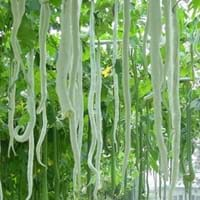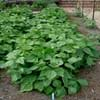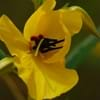Origin
Central America, South America
India, Philippines, Southeast Asia
Types
Bush Beans, Pole Beans
Not Available
Number of Varieties
Not Available
Habitat
Cultivated Beds
Loamy soils, Moist Soils, Subtropical climates
USDA Hardiness Zone
Not Available
5-7
AHS Heat Zone
Not Available
12-1
Sunset Zone
A1, A2, A3, H1, H2, 1a, 1b, 2a, 2b, 3a, 3b, 4, 5, 6, 7, 8, 9, 10, 11, 12, 13, 14, 15, 16, 17, 18, 19, 20, 21, 22, 23, 24
A1, A2, A3, H1, H2, 1a, 1b, 2a, 2b, 3a, 3b, 4, 5, 6, 7, 8, 9, 10, 11, 12, 13, 14, 15, 16, 17, 18, 19, 20, 21, 22, 23, 24
Habit
Vining/Climbing
Vining/Climbing
Flower Color
Lavender
Yellow, Orange, Dark Green
Flower Color Modifier
Bicolor
Bicolor
Fruit Color
Purple
Yellow, Dark Green
Leaf Color in Spring
Green, Purple
Green, Dark Green
Leaf Color in Summer
Green
Green, Dark Green
Leaf Color in Fall
Green
Green, Dark Green
Leaf Color in Winter
Not Available
Not Available
Plant Season
Spring, Summer, Fall
Summer, Fall
Sunlight
Full Sun
Full Sun
Growth Rate
Fast
Very Fast
Type of Soil
Loam, Sand
Loam, Sand
The pH of Soil
Neutral, Alkaline
Neutral
Soil Drainage
Well drained
Well drained
Bloom Time
Indeterminate
Indeterminate
Tolerances
Drought
Drought
Where to Plant?
Container, Ground, Pot
Ground
How to Plant?
Seedlings
Seedlings
Plant Maintenance
Medium
Medium
Watering Requirements
Do Not over Water, Requires regular watering, Water evenly
Keep ground moist, Requires regular watering
In Summer
Lots of watering
Lots of watering
In Spring
Moderate
Moderate
In Winter
Average Water
Average Water
Soil pH
Neutral, Alkaline
Neutral
Soil Type
Loam, Sand
Loam, Sand
Soil Drainage Capacity
Well drained
Well drained
Sun Exposure
Full Sun
Full Sun
Pruning
Remove damaged leaves, Remove dead branches, Remove dead leaves
Cut out old flower stalks, Remove dead or diseased plant parts
Fertilizers
5-10-10 fertilizer
Nitrogen, N-P-K balanced liquid fertilizer, Potassium
Pests and Diseases
Alternaria Leaf Spot, Anthracnose, Aphids, Armyworm, Bacterial Blight
Army-worms, Bacterial leaf spot, Blight, Cucumber beetles, Cucumber mosaic, Cutworms, Fusarium leaf spot, Red spider mite
Plant Tolerance
Drought
Full Sun, Salt and Soil Compaction
Flower Petal Number
Single
Single
Foliage Texture
Coarse
Coarse
Foliage Sheen
Matte
Matte
Attracts
Not Available
Bees, Flies, Flying insects
Allergy
Not Available
Hypoglycaemic Coma, Irregular Heart Rhythm, Miscarriage
Aesthetic Uses
Not Available
Not Available
Beauty Benefits
Beautiful Skin
Glowing Skin, Moisturizing, Nourishes scalp
Environmental Uses
Fixes Nitrogen
Food for animals
Medicinal Uses
Cancer, Diuretic, Homeopathy, Hypotensive, Miscellany
Diabetes, Gastrointestinal disorders, Jaundice, Laxative, Leprosy, Weight loss
Part of Plant Used
Leaves, Seedpod, Seeds
Fruits, Leaves
Other Uses
Used for making brown dye, Used in biomass, Used in in reviving woollen fabrics
Cosmetics, Culinary use, Repellent
Used As Indoor Plant
Yes
No
Used As Outdoor Plant
Yes
Yes
Garden Design
Container, Edible, Herb, Vegetable, Vine
Dried Flower/Everlasting, Vine
Botanical Name
PHASEOLUS vulgaris 'Purple King'
Trichosanthes cucumerina
Common Name
String bean, Field bean, French bean
snake gourd, serpent gourd, chichinda, padwal
In Hindi
String Bean
चिचिण्डा
In German
Bohne
Schlangenhaargurke
In French
Haricot vert
Trichosanthes cucumerina
In Spanish
String Bean
snake gourd
In Greek
Αμπελοφάσουλο
φίδι κολοκύθα
In Portuguese
Feijão de corda
snake gourd
In Polish
Fasolka szparagowa
Gurdlina ogórkowata
In Latin
Gloria Bean
snake gourd
Phylum
Magnoliophyta
Magnoliophyta
Class
Magnoliopsida
Magnoliopsida
Order
Fabales
Cucurbitales
Family
Fabaceae
Cucurbitaceae
Clade
Angiosperms, Eudicots, Rosids
Angiosperms, Eudicots, Rosids
Tribe
Phaseoleae
Not Available
Subfamily
Faboideae
Papilionoideae
Number of Species
Not Available
Season and Care of String Bean and Snake Gourd
Season and care of String Bean and Snake Gourd is important to know. While considering everything about String Bean and Snake Gourd Care, growing season is an essential factor. String Bean season is Spring, Summer and Fall and Snake Gourd season is Spring, Summer and Fall. The type of soil for String Bean is Loam, Sand and for Snake Gourd is Loam, Sand while the PH of soil for String Bean is Neutral, Alkaline and for Snake Gourd is Neutral.
String Bean and Snake Gourd Physical Information
String Bean and Snake Gourd physical information is very important for comparison. String Bean height is 210.00 cm and width 60.00 cm whereas Snake Gourd height is 60.00 cm and width 90.00 cm. The color specification of String Bean and Snake Gourd are as follows:
String Bean flower color: Lavender
String Bean leaf color: Green and Purple
Snake Gourd flower color: Yellow, Orange and Dark Green
- Snake Gourd leaf color: Green, Dark Green
Care of String Bean and Snake Gourd
Care of String Bean and Snake Gourd include pruning, fertilizers, watering etc. String Bean pruning is done Remove damaged leaves, Remove dead branches and Remove dead leaves and Snake Gourd pruning is done Cut out old flower stalks and Remove dead or diseased plant parts. In summer String Bean needs Lots of watering and in winter, it needs Average Water. Whereas, in summer Snake Gourd needs Lots of watering and in winter, it needs Average Water.





